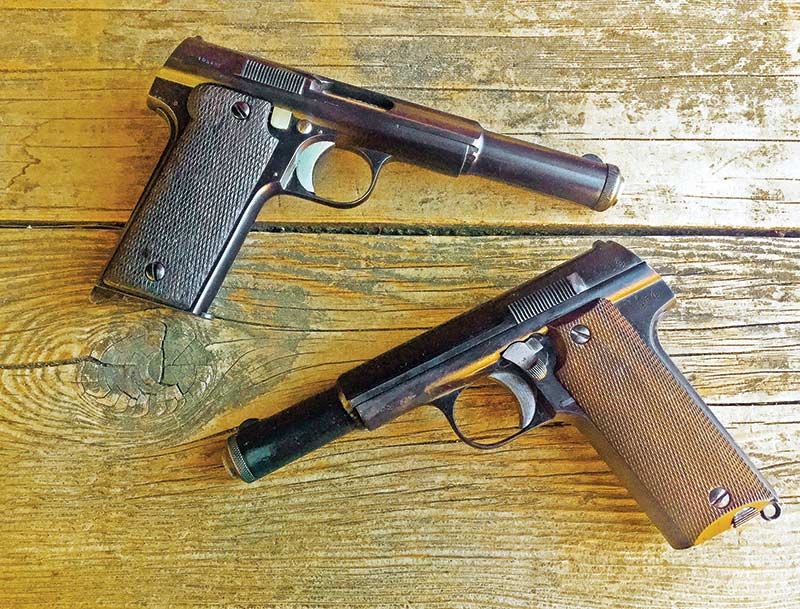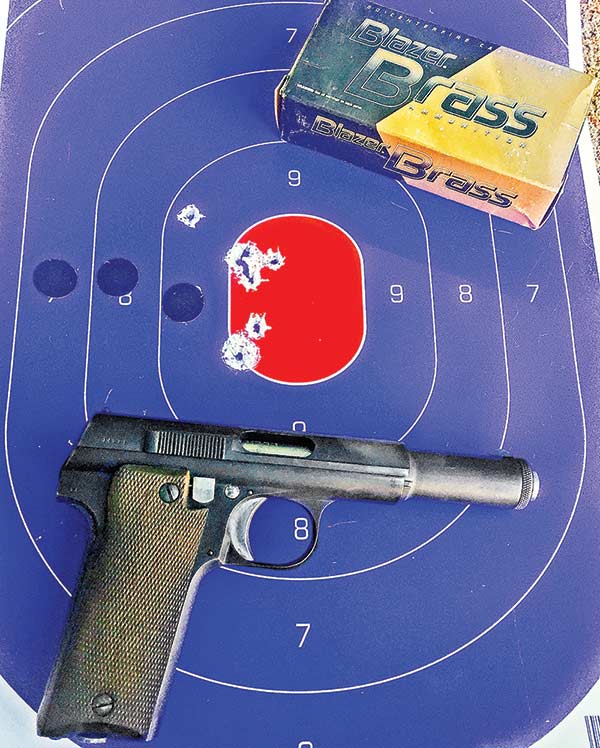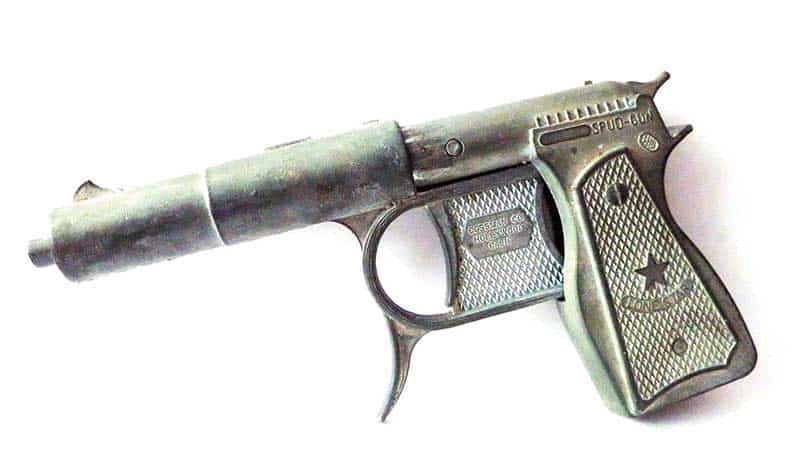 Astra M400 (top) and M600 (bottom) — A slightly longer barrel and 9×23 Largo
Astra M400 (top) and M600 (bottom) — A slightly longer barrel and 9×23 Largo
chambering differentiated the earlier M400 from the 9mm Parabellum M600.
Two of the most distinctively retro “hammerless” pistols in the vintage military market you’re likely to find are the Astra Model 400 and 600. They’re darn near impossible to mistake for anything else — being vaguely reminiscent of a spud gun or squirt gun, depending on your childhood frame of reference.
But these two Spanish-made pistols don’t shoot potato plugs or a tepid stream of water. Our two specimens — courtesy shooting buddy, Doug Fee — handle a pair of 9mm cartridges. One is a world-standard while the other is, for all practical purposes, moribund by comparison.
The German Connection
The M400 was produced from 1921 to 1950 by Astra-Unceta y Cia SA and was chambered in several calibers, most notably the 9×23 Largo (also referred to as the 9mm Bergmann-Bayard). The M600 was a shortened 9×19 Parabellum version made at the behest of the German military, which found itself strapped for sidearms during World War II. As a result, many M600s (known as the M600/43) ended up tucked away in the flight jackets of Luftwaffe air crewmen.
Once the Allies closed off southern France, the M600’s Spanish pipeline dried up and the remainder of the guns ended up in various countries after the war ended, including Chile, Turkey and, yes, West Germany. Many also ended up in the U.S. via Interarms. They are often described as being “intended for a Nazi contract but never delivered.”
Retracting the slide and turning the barrel clockwise allows the
barrel/slide assembly to be pulled forward off the frame.
A Pair of Pistolas
Both the M600 and M400 have grip angles — while not exactly like a T-square — are somewhat similar to the Soviet T-33. However, the powerful recoil spring, beefy receiver necessitated by the straight blowback action and low bore axis make them very tractable as we discovered at our initial range session. This isn’t much of an issue with the standard pressure 115-grain FMJs we used in the 9×19 M600, but it was a bit more appreciated in regard to the slightly snappier M400 in 9×23 Largo.
The 9×23 Largo, in service trim, featured a 127-grain bullet at close to 1,200 fps, which is reasonably close to the original 130-grain .38 Super in terms of performance. It was designed in 1901 by Theodore Bergmann and features a case length of 23.11mm, as opposed to the 19.5mm case of the vastly more successful 9mm Parabellum. The Parabellum, it should be noted, is loaded to higher pressures.
In terms of safety features, both the M400 and M600 feature an embarrassment of riches: a side-mounted external safety, a grip safety and a magazine disconnect. As well, Astras have a hold-open and the slide locks to the rearward position on the last shot, magazine capacity of both models being eight rounds.
However, the trigger pulls were somewhat less than lovable — 8 lbs. for the M600, but a more amenable 5-1/2 lbs. for the M400 in 9mm Largo.
The M600 features a 5.4″ barrel, an overall length of 8.1″ and a weight of 38-1/2 oz. Magazine capacity is eight rounds. The slightly larger M400 is slightly heavier at 40 oz. thanks to a reinforced slide and 5.9″ barrel. Both guns feature fairly rudimentary fixed sights with a V-notch rear.
Modern 9×23 Winchester ammo should definitely not be used in an
Astra 400. Best of show: The M600 preferred 124-grain Blazer Brass 9mm Parabellum FMJ at 25 yards.
Range Results
Getting hold of 9mm Largo ammo proved a bit of a challenge, however, we did find some early 1950s 127-grain stuff from Fabrica de Armas de Toledo and a precious — and pricey! — handful of 124-grain noncorrosive TMJ from CCI Blazer, of which we were able to talk Doug out of.
Naturally, there was no such problem with the 9mm Parabellum stuff. We used some bulk steel-case Winchester 115-grain FMJ along with 124-grain and 147-grain Blazer Brass FMJ. All were standard pressure offerings of course — we saw no earthly reason to subject the elderly M600 to any “two buck a pop” high-zoot Plus-P.
The 9mm Parabellum M600’s best 25-yard group was with a 124-grain Blazer Brass FMJ, which clocked 1,090 fps. It shot “closest to the sights” as well. As for the M400? Well, the Spanish surplus Largo ammo shot a bit low-left and not as tight as Doug’s long-hoarded Blazer stuff. Of the 9mm Largo we were able to scrounge, we only had enough to chrono the Spanish stuff which averaged a respectable 1,180.
To many shooters of “a certain age,” Astra autos resembled a ’50s -era “spud gun” (above)
Vintage Coolness
All in all, no one could reasonably complain about the accuracy of either pistol. One of my shooting buddies commented, “If only they had better triggers and bigger sights.” But griping about those factors in regard to a pre-war era service pistol is kind of like complaining it gets cold and windy around January in North Dakota.
Field-stripping consists of turning the serrated nose cap a quarter turn, removing the bushing and spring then retracting the slide and locking it back to expose a series of “grasping notches” on the barrel. Turning the barrel clockwise will free the barrel/slide assembly from the frame.
Both the Astra 600 and 400 are pretty cool items. No, you’re not going to find either for what you would’ve paid back in the Nifty Fifties, but they can still be had for a couple hundred bucks under a grand or so.